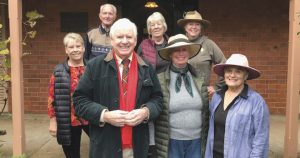“75 Million trips per day are taken by private car in Australia, with an average of 1.1 persons per car. More than 50% of those trips are for distances of 5km or less.”
One way to alleviate traffic congestion and create more parking spaces is a critical mass of individual decisions to take less, or no short trips by private car. The paucity of car parking at some NW Metro rail transit hubs might be a subtle push toward such changes in commuter behaviour.
‘Active transport’ isn’t just about biology or an anti-car conspiracy theory- it has grown into a global social movement, benefitting leading cities and the environment the world over. Anyone who is privileged enough to travel overseas, would agree that you don’t see enormous parking lots along, say, the Paris Metro, or the busy Hammersmith transit hub in London. But what you do see are highly efficient public transport services, orderly bike share scheme docks and extensive networks of dedicated or shared bicycle lanes or footpaths; all radiating out for 20km or more to and from every transit hub. Cyclists and pedestrians have priority over motor vehicles- particularly at busy traffic intersections, while obstructive regulations and petty police ‘crackdowns’ on bicycle or pedestrian ‘offenders’ are conspicuously absent.
NSW State, however, currently has over 100 draconian demerit fines, custom crafted and updated in 2016, which obstruct bicycling in NSW, starting at $112 right up to a shameful $448. Pedestrians only have a modest 41 demerit fines to worry about and pay $75 for each ‘offence.’ This criminalisation of ordinary citizens just trying to do something very positive is depressing if you try to engage with your external environment and live an active, healthy lifestyle. It also completely undermines and contradicts the State’s own commitments to active transport and health.
Every beautifully designed and landscaped new station on the NW Metro rail link is a model example of how to use public and active transport to get from A to B. But around two of them, namely Castle Hill and Cherrybrook, the good work is only within a small radius. Further infrastructure for cycling and walking is still to be retrofitted around these stations because they are both perched upon confined, steep-sided ridgelines traversed by Castle Hill Road and Old Northern Road. These busy arterial roads currently accommodate no other personal transport option, except a fossil fuel assisted one. Fortunately, the other NW Metro Stations are not on ridgelines and have been ‘future-proofed.’ Surrounding geography is fairly flat and they are quite easy and safe to access on foot, or with a bicycle because this has been included with previous and existing infrastructure developments in areas surrounding Showgrounds, NW, Bella Vista, Kellyville, Rouse Hill and Tallawong rail stations.
But for those residing west of Galston Gorge in the vicinity of Arcadia, Galston, Glenorie, Forest Glen or Kenthurst and beyond- we are all just a bit too ‘far’ away (more than 10km, but ‘far’ is a state of mind!) to regularly benefit from the nearest rail stations. So we’ve developed a culture of driving everywhere by default, as we have had to be self-sufficient ‘out here’ for decades. We decided to live far away from city crowds and consistent metro services. Besides, nothing beats the convenience and luxury of having a personal car to use whenever you like. However, change is here now and it’s irrevocable. How we manage that change to benefit the environment- and us as a community- is key. Ensuring we all have access to cheap, efficient and safe alternatives to private car use will become a critical quality of life factor in the not too distant future.
South-bound commuters, no matter what bridging transport they choose, still face several obstacles to access the NW Metro, and it appears we have not been considered in transport plans doing the ‘have your say’ rounds of 2019.
*Old Northern, Newline and Castle Hill Roads all have frustrating bottlenecks and some rather lethal intersections. Road upgrades are way overdue and not scheduled for anytime soon.
*There are seven schools along this ridgeline alone and thousands of scholars go to and from school every day in convoys of private cars. ‘School Traffic’ and parking woes in the vicinity of these schools are just accepted as part of the daily ritual while perpetuating a cycle of dangerous traffic conditions around schools- but what other alternatives are there currently? Primary and high school kids (and their parents) should have the choice of safe, active transport routes to schools and work, because statistically, they certainly are not safe in their cars. There were 140 driver/ passenger deaths in motor vehicles as opposed to 8 cyclist and 34 pedestrian deaths in the first half of 2019 in NSW.*
*Local bus services are still too infrequent and many don’t go direct- enormous, mostly empty buses are not very appealing and will not coax us out of our cars either.
* It would take a very average cyclist just 45minutes to cycle commute from Galston to Castle Hill (12km) or Cherrybrook (11km) via Old Northern Road. If you own an E-bike to assist you up the hills, your NW Metro cycle commute will take under 30minutes! A bicycle uses a fraction of the road space that a car does, so one can bypass any traffic bottlenecks. Cycle commuting south to NW Metro and back may be quicker than driving there in peak hours, but is the mental stress and threat of road rage, injury or an untimely death, worth it? Due to our inadequate access roads, no cycle path networks and steep off-ridgeline gradients- this is a difficult and dangerous route to ride.
A safer bet, if commuting in by car from the semi-rural north, might be to compromise and park a good 2 to 5km away from the cars and associated Ranger Danger circling train stations. Research and plan your route, choosing a suitable station. Extract your bicycle from the car and enjoy cycling through quiet suburbs, business parks or along any cycle paths you might find, while safely and efficiently bridging that proverbial ‘last mile’ to and from your rail station of choice. But do remember, we are one of only three countries in the world that mandates wearing a bicycle helmet. (aka ‘foam hat’) The penalty is an incommensurate $337 fine if you don’t wear one or perhaps forgot to fasten the strap!
All new stations have adequate bicycle parking, but some of it is still being rolled out. Cyclists have a choice of exterior racks, free bike sheds or hire lockers for that hero $10,000 Colnago ! Station lifts can take up to five bikes at a time if you need to take yours with on the train, but rail network travel conditions apply.










